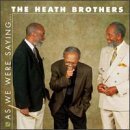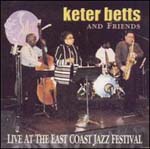Jazz Outside of the City
Since Whiplash, lots of people have sent well-wishes, including bassist Bill Crow who also mentioned a new venue:
There’s a new restaurant, called Division Street, in Peekskill NY that is trying out a jazz policy. I played there Friday night with Carmen Leggio and Bucky Pizzarelli, and it was nice. Good sounding room, and the people actually shut up and listened to the music! The boss says he plans to buy a good piano soon, so we’re hopeful. I’ve closed several jazz clubs in Westchester over the years, and another one, 17 Main, just bit the dust in Mt. Kisco. So it is good to see a decent venue open up. Carmen is a rare treat…playing a style that ranges from Hawk and Byas to Al and Zoot, he’s one of the last of that breed of instinctive players with a great sound and easy swing.
I am not familiar with Mr. Leggio, so I did a little googling and found this recording of Smile/Tarrytown Tenor with Milt Hinton, Derek Smith, George Duvivier, Ronnie Bedford, John Bunch and Butch Miles, and a 1999 article – Carmen Leggio: Young Man With A Horn – by Fred Cicetti that included this intriguing analogy: Leggio blows tenor the way Willie Mays ran down a flyball. They both let you know from the get-go that you’ll never be able to do it their way.
Speaking of outside the city, I also received well wishes from drummer Kenny Harris in England. You can also find him on page 248 of Doug Ramsey‘s Desmond bio, Take Five.
Emails about Al McKibbon included
“Dear sweet Al…..” (a mutual friend)
“This summer has been tough on old bass players…I’m starting to look over my shoulder.” (a bassist)
and
“I had the opportunity to play with Al on several occasions throughout the years here in L.A., and the things that impressed and inspired me the most were his deep, dark sound and the notes he chose to play. Al played the bass in a manner that you felt as well as heard. His sound came up at you from the floor. And no matter how convoluted the chord changes might be on any given song, Al always seemed to find the best notes to play. He was truly the heartbeat and, to my way of thinking, one of the unsung heroes of the bass world.”
That last one was from drummer Michael Stephans, who just launched a very lovely website of his own.
Radio Days
I’ve been corresponding with discjockey/drummer Dick McGarvin (he was also at McKibbon’s funeral) and he wrote belatedly about last month’s Johnny Pate piece
The day you had the piece on Johnny Pate, I played my LP of “Round Trip†by Phil Woods – it hadn’t been off the shelf in years – and was reminded of what a good album it is. Oh, and thanks to your blog, I finally learned who was in the great sounding rhythm section on “Round Tripâ€. There was no mention of personnel on the album!
That’s why I blog – not for the thanks, but for the kick of introducing, or in this case, reintroducing someone to some good music, a great book, or even just an interesting thought. Spotlighting those who go unnoticed or unmentioned is another good reason.
McGarvin went on to reminsce about the good old days of radio:
I remember playing it [“Round Trip”] on the radio when it was released…and I wasn’t even working at a jazz station then. It was at KSFO, San Francisco, which was an AM personality oriented MOR station playing everything from Sinatra to Paul Simon, Peggy Lee to the Carpenters, Shearing to the Tijuana Brass. That list also included Ella, Steve Lawrence, Brazil 66, Otis Redding, The Fifth Dimension, Kenny Rankin, Stevie Wonder, Nancy Wilson, Cannonball’s MERCY MERCY MERCY, Van Morrison. Well, you get the idea. (WNEW probably would have been the closest New York equivalent at the time.) What’s amazing, considering today’s homogenized radio, is that each disc jockey in those days picked his own music, so I was able to mix in the occasional Oscar Peterson or something like one of the more familiar songs from the Phil Woods album. It was wonderful to be able to program such a wide variety of music into one show…and it worked. But, sadly, that kind of radio station is of another time and doesn’t exist anymore.
The pendulum is bound to swing again…someday. Meanwhile, I am wondering if it is time to check out the XM Satellite. TT seems to think so.




 When in pain – physical or mental – the two things I think most soothing are music (specifics vary by person and will be addressed in a later post) and the unconditional love of a pet. When I was fighting the cancer war, ensconsed at Glendale Adventist Hospital, they had a visiting pet program. I remember one morning, when in one of my darker moods, two strangers walked into my room with two small dogs. I was not in the mood to talk with friends, let alone strangers, but they said that was okay and asked if I wanted to pet the dogs. The dogs were already on my bed and snuggling up — irresistable. The couple carried on their own conversation between themselves and left me to the dogs. I don’t know how long they stayed, it may have been only fifteen minutes, but the effect was long lasting and far outweighed the ocassional unrequested drop-ins from various clerics.
When in pain – physical or mental – the two things I think most soothing are music (specifics vary by person and will be addressed in a later post) and the unconditional love of a pet. When I was fighting the cancer war, ensconsed at Glendale Adventist Hospital, they had a visiting pet program. I remember one morning, when in one of my darker moods, two strangers walked into my room with two small dogs. I was not in the mood to talk with friends, let alone strangers, but they said that was okay and asked if I wanted to pet the dogs. The dogs were already on my bed and snuggling up — irresistable. The couple carried on their own conversation between themselves and left me to the dogs. I don’t know how long they stayed, it may have been only fifteen minutes, but the effect was long lasting and far outweighed the ocassional unrequested drop-ins from various clerics.
